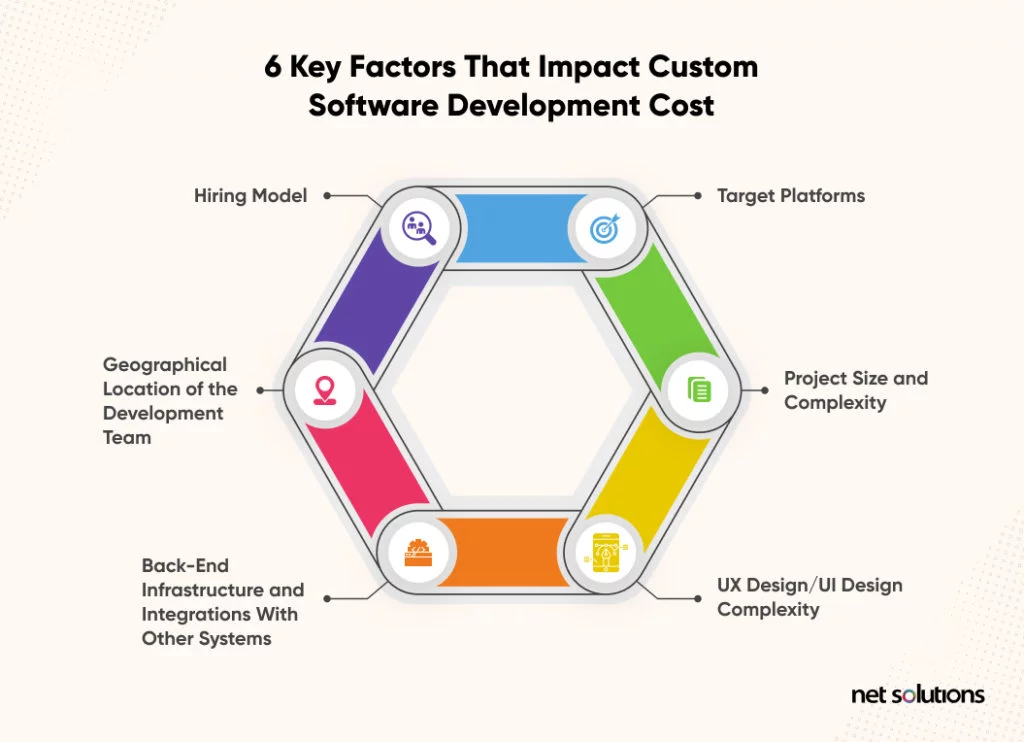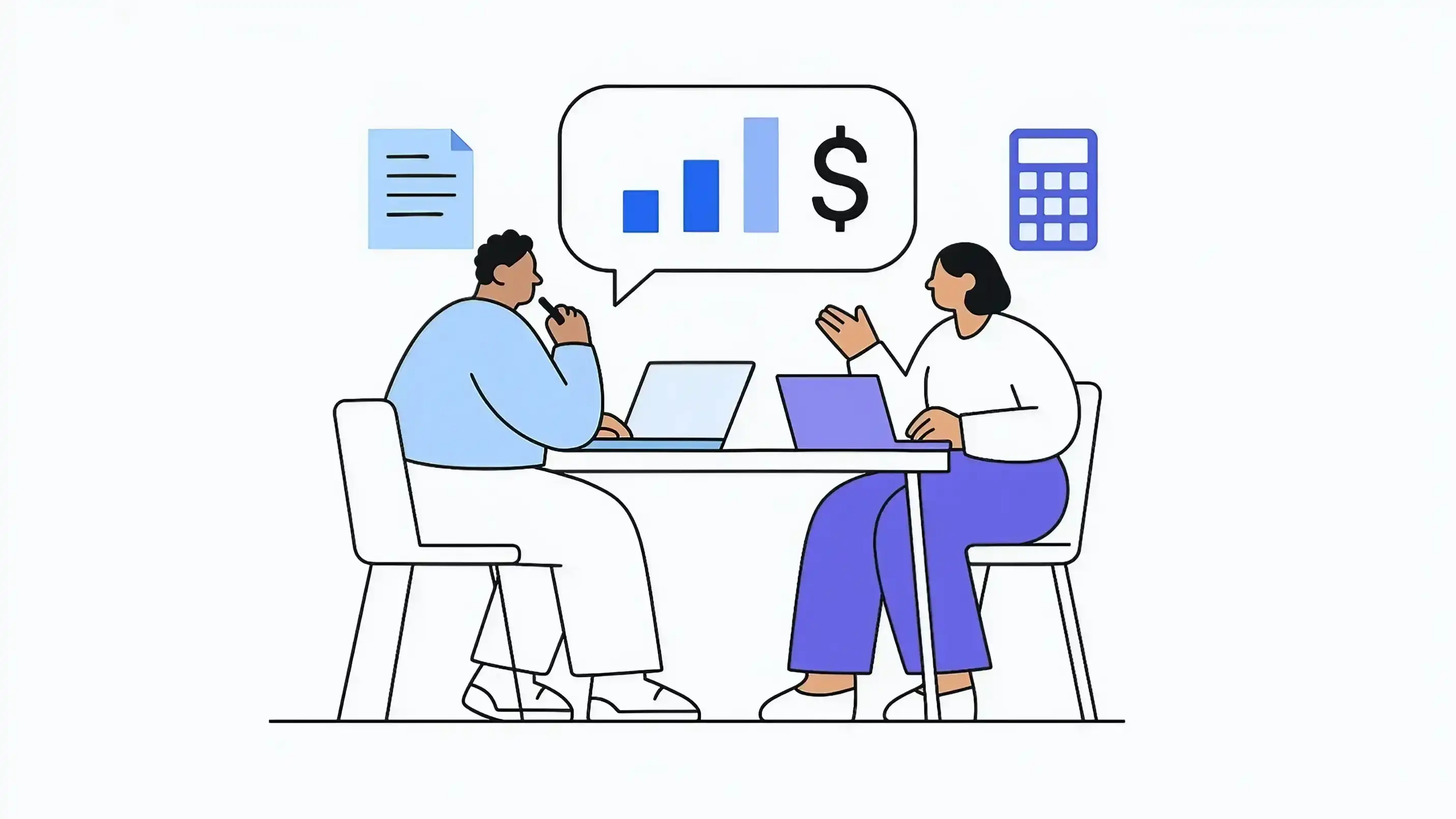Whether you’re a business owner or a project manager, accurately estimating custom software development costs can be challenging. The blog unlocks the secrets to estimating custom software development costs in 2025 while diving into the key factors that influence project expenses, from scope and complexity to technology choices and team composition.
A quick Google search for the cost of custom software development might raise more questions than answers.
After all, prices vary so much from one software development project to the next that estimating a budget might seem impossible. That can feel overwhelming to a project manager or an entrepreneur searching for a software development outsourcing partner, so we created this short guide to make sense of it all.
We’ve outlined the various factors that influence cost, including:
- The type of software you’re planning to create
- Elements of the software itself, such as size, complexity, and functionality
- Different hiring models (e.g., outsourcing, freelancing, or hiring an in-house team)
This guide will help you create an informed, realistic budget for your new software project so you can find talented software developers.
How Much Does Custom Software Development Cost?
Software development costs can vary from $20,000 to $500,000 or more, which is quite a range—but don’t worry! This guide will help you work out a rough estimate of your costs by considering factors such as your software’s functionality, scheduled development time, User Experience (UX) requirements, and many other elements that impact the overall cost of a software development project.
Another factor that makes a big difference is whether you hire your in-house software development team or work with a software development company.
Outsourcing can help cut costs, so a recent study found that 99% of IT professionals see value in outsourcing. Outsourcing is expected to grow by 70% this year because it’s an attractive option.
All these factors make it challenging to come up with a rough estimation for software development costs across the board, but once you study the details, you can build your software development budget.
Average Cost for Custom Software Development By the Type of Software
The first step in narrowing down potential costs for custom software development services is identifying the cost range for the type of software you want to create.
The costs for some types of software are easier to pinpoint, and again, your desired functionality and the required labor for both the front-end and back-end development will significantly affect the budget.
However, knowing the type of software you want to create will determine the ballpark prices.
Here are some general costs for different types of software products.
- Content Management System (CMS): A CMS manages and updates website content without manually changing the code. CMS solutions such as WordPress or Drupal might cost $20,000 – $50,000.
- Software as a Service (SaaS): SaaS apps can vary in cost depending on their features. SaaS apps like Slack or Salesforce can range from $20,000 to $500,000.
- Enterprise Resource Planning (ERP): ERP software requires a great deal of integration with other systems’ APIs and often requires quite a bit of customization to match specific business needs. Designing a Microsoft Dynamics 365 or Oracle Cloud ERP system would likely cost over $100,000.
- Client Relationship Management (CRM): CRM software can vary considerably based on your needs. A fully functional CRM platform might average around $100,000, while something with vast features and customizability, like Salesforce or Hubspot, might cost $600,000 or more.
- Custom eCommerce Store: An eCommerce store based on software like Magento Commerce would likely cost you between $20,000 and $70,000. Many online stores, such as the Land Rover website, Graze, and other successful sites, are built on Magento. They are all good examples of custom eCommerce stores and show what you can do with the software.
- Marketplace App: A customer-facing marketplace app like Airbnb might cost around $75,000.
- Dating App: A dating app like Bumble might cost around $45,000.
- Social Media App: Social media apps like Instagram and Twitter vary considerably in price, depending on which features you want to include. A reasonable estimate is between $60,000 – $300,000.
It’s important to note that your initial costs may run less than these price ranges (or at least at the lower end) if you start with a Minimum Viable Product (MVP).
An MVP allows you to test product-market fit before investing excessive money in features your target audience doesn’t actually want.
If you attract a base of users who like your MVP, you can gather feedback to guide future product development and help you create subsequent software versions they’ll love.
Looking to create a Request for Proposal (RFP) to gather bids? Take a look at our software RFP templates.
6 Key Factors That Impact Custom Software Development Cost
While the types of software you want to create can give you a rough idea of the costs involved, software engineering and design project costs come down to the expertise and labor involved.
The following six key factors will play a significant role in determining the development process, the functionality of your software, and ultimately the price.

1. Target platforms
Are you designing a mobile app for Android or iOS? Are you hoping to create a cross-platform app that serves both? Perhaps you’re creating a web-based app instead of a mobile or desktop app for Windows or Mac OS?
App development and design for each of these systems has its own set of requirements, and naturally, it will cost you more to develop a software application on multiple platforms.
If you’re developing an MVP, it often makes sense to focus on the platform your target audience will most likely use.
For example, if you gain traction on a customer-facing iOS mobile app used for dating, you can always expand to Android or create a web-based app in future versions.
On the other hand, if you’re creating enterprise software to address the business needs of Fortune 1000 companies, starting with a web-based app (for Saas products) or a Windows-compatible software product (for a desktop app) makes more sense.
2. Project size and complexity
Software size is the most significant factor influencing custom software development pricing.
How long it takes to bring your product to market is significantly tied to how many “screens” the users can potentially see when they use your app. In other words, when you click, scroll, or take an action within the app, something changes—a new screen appears—and each screen requires software development labor.
Usually, you will limit the number of screens in an MVP, saving money on startup costs. This reduces future expenses since you’re not paying to create features your target audience doesn’t want or need.
3. UX design/UI design complexity
User Experience (UX) and User Interface (UI) design are significant because an intuitive, easy-to-use interface will significantly impact your adoption odds and overall success.
Full-service partners who create custom software solutions will offer creative design and UX design in their list of services. This includes wireframing and prototyping services, where they can work with you to create the bespoke experience you’re hoping to achieve.
The more effort you spend on creating an optimal user experience and a beautiful interface, the more that will increase the price tag. As with all product development, there’s a balance between budgetary constraints and creating the perfect product.
Once again, remember that an MVP doesn’t have to provide a mindblowing, utterly seamless User Experience. It does, however, have to give a working solution that doesn’t frustrate customers. Otherwise, it’s not even minimally viable and isn’t market ready!
4. Back-end infrastructure and integrations with other systems
UI and UX design constitute the front end of your software application, but that’s just the tip of the iceberg. The software’s backend is a vast underbelly of processes and functions that draw from massive databases, and they may even interact with other systems through their APIs.
Airbnb has a clean, attractive user interface that works well on its web-based app and mobile operating system. The user sees an easy search feature, filters, booking options, and photos. The platform must interact with maps, calendars, real-time updates, messaging connected to email, credit card processing, and more. All these things are tied to backend web development; an extensive backend will increase the development cost.
One of the more essential aspects of backend development involves data security. If your customers’ data is compromised, it will not only damage your reputation—you may be held legally liable. In other words, don’t skimp on proper backend security!
5. Geographical location of the development team
The location of your development team will greatly influence the cost of your software development project because the cost of living varies considerably around the world.
Naturally, labor costs will not be the deciding factor in choosing a software development partner—you don’t want to sacrifice quality, ease of communication, or security in your search for the best deal.
That said, software development firms in places like India and Eastern Europe have employees fluent in English (or your native language), and many provide excellent value.
Here is a sample of the average hourly rates for software development in different parts of the world, giving you a general sense of how much the price may vary. Check out our blog post on offshore software development rates for an in-depth analysis.
| Region | Hourly Rate |
|---|---|
| United States of America | $130-$165 |
| United Kingdom | $110-$130 |
| Australia | $110-$130 |
| Western Europe | $90-$110 |
| Eastern Europe | $35-$55 |
| India | $25-$35 |
6. Hiring model
You have three main options when hiring software developers to build your app.
One option is to hire an in-house team, where each member works for you as a full-time employee.
Another option is to hire individual freelancers who work for you hourly or per project.
The third option is to hire an outsourced development team.
- In-house teams: In-house software design and development teams will get to know your company culture intimately, but they’re the priciest option. Even setting aside the cost of labor, hiring in-house employees comes with all sorts of hidden costs—from benefits to payroll taxes. Plus, when work slows, you pay them to twiddle their thumbs. That’s why it often makes sense to keep an in-house team lean and supplement their work with outsiders.
- Freelancers: Many freelance software developers are available for hire and are pretty talented. You can find good quality developers at a reasonable price. The downside is that since they’re not part of a larger team, they tend to be narrowly focused on their tasks. As such, if you hire freelancers, you’ll need strong in-house project management professionals to keep everyone on track—filling that role can be costly.
- Outsourcing: Outsourcing software development, especially overseas, is exceptionally cost-effective, assuming you choose your outsourcing partner wisely. A full-service agency will have designers, developers, Q&A specialists, and project managers on staff who can ensure smooth, efficient production. Just be sure to thoroughly vet your outsourcing partner and choose a team that is proficient in English (or whatever language your in-house staff speaks).
The following chart outlines the advantages and disadvantages of each hiring model.
| In-house | Freelance | Outsourced | |
|---|---|---|---|
| Cost | Expensive: In-house employees come with hidden costs, including payroll taxes, benefits, and downtime. | Affordable: Freelancers typically offer affordable rates, especially when they’re from overseas. | Affordable: Outsourced teams, especially from certain countries, are usually quite affordable. |
| Communication and Internal Cohesion | High-level: In-house teams, when adequately managed, can usually communicate efficiently and work well together. | Moderate to Low: Freelancers often struggle to communicate and connect with the team without a strong project manager to guide them. | Moderate to High: Communication can be excellent with outsourced teams, assuming you choose a partner that is fluent in your language and takes a strategic approach to collaboration. |
| Contract Type | Long-term/Rigid: When you hire in-house, you are signing a long-term employment contract with all the obligations. | Short-term: Freelance contracts are short-term and flexible. You can let them go or reduce their work at any time, but they might also leave you at any time. | Flexible: Software development firms can work on short-term and long-term contracts, providing the flexibility to scale and the freedom to reduce the work you give them when business slows. |
Remember that you can combine these models, hiring freelancers or outsourced teams to help you scale and adapt as work ebbs and flows.
You can hire an outsourcing partner to cover specific development tasks while your in-house team works on other elements. We did that for Kitco here at Net Solutions—we handled their Quality Assurance (Q&A) in India while their in-house team slept. The in-house employee went to work each morning to find a complete report of the bugs they needed to address, and KitCo developed its software around the clock.
Can Software Be Developed to Fit a Certain Budget?
Okay, so you have a specific budget and know what you want to create. Can a software development team work with you to build your MVP according to your budgetary constraints?
Absolutely! Assuming you’ve got a reasonable budget that doesn’t skimp on essential features that make your app functional and secure, a good software development partner can strategize with you to prioritize the right features.
Not sure whether you’ve got a reasonable budget? Contact Net Solutions for a free consultation, and we’ll give you a realistic sense of how much your project will cost and how long it will take to complete.
Get a Quote for Custom Software Development Services
Net Solutions has designed and developed mobile apps for well-known organizations like
American Golf and
IMG, along with MVPs for ambitious startups.
Frequently Asked Questions
Maintain clear communication with your development team, regularly review project progress, prioritize features and functionality, and consider implementing an agile development methodology for better cost control.
You must evaluate mobile app RFP proposals based on the following factors:
- Third-party integrations
- Complex user interfaces
- Large scale data management
- Cross-platform compatibility
Yes, leveraging pre-built components or frameworks can save development time and costs. However, customizations and integrations may still be required, so it’s important to assess the trade-offs carefully.
Assess the project’s complexity, divide it into development phases, consider the team’s size and availability, and communicate with the development team to obtain realistic timelines for each phase.






